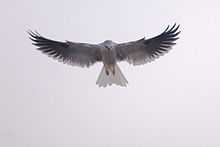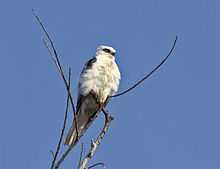White-tailed Kite
| White-tailed Kite | |
|---|---|
 | |
| White-tailed kite with prey. | |
| Conservation status | |
| Scientific classification | |
| Kingdom: | Animalia |
| Phylum: | Chordata |
| Class: | Aves |
| Order: | Accipitriformes |
| Family: | Accipitridae |
| Genus: | Elanus |
| Species: | E. leucurus |
| Binomial name | |
| Elanus leucurus (Vieillot, 1818) | |
| Synonyms | |
|
Elanus caeruleus leucurus | |
The White-tailed Kite (Elanus leucurus) is an elanid kite of genus Elanus found in western North America and parts of South America.
Their coloration is gull-like, but their shape and flight falcon-like, with a rounded tail. Mainly white underneath, they have black wingtips and shoulders. A mid-sized kite, it measures 35–43 cm (14–17 in) in length, spans 88–102 cm (35–40 in) across the wings and weighs 250–380 g (8.8–13.4 oz). Both the wings, at 29–32.8 cm (11.4–12.9 in) each, and the tail, at 15.1–18.6 cm (5.9–7.3 in), are relatively elongated. The tarsus measures around 3.6 cm (1.4 in).[2]

For some recent decades, it united with the Black-winged Kite of Europe and Africa in Elanus caeruleus, and collectively called Black-shouldered Kite.[3] More recently it was argued that the White-tailed Kite differed from the Old World species in size, shape, plumage, and behavior, and that these differences were sufficient to warrant specific status.[4] This argument was accepted by the American Ornithologists' Union, so the White-tailed Kite has its original name back. Meanwhile, the Old World E. caeruleus is again called Black-winged Kite, while the name Black-shouldered Kite is now reserved for an Australian species, Elanus axillaris, which had also been lumped into E. caeruleus but now regarded as separate again.



The White-tailed Kite was rendered almost extinct in California in the 1930s and 1940s by shooting and egg-collecting, but they are now common again. Their distribution is patchy, however – they can be seen in the Central Valley and southern coastal areas, open land around Goleta including the Ellwood Mesa Open Space, marshes in Humboldt County, and also around the San Francisco Bay, but elsewhere they are still rare or absent. They are also found in southern Texas, on the Baja California peninsula, and in eastern Mexico, and on a global scale they are not considered threatened species by the IUCN.[1] On rare occasions the bird can be found far afield. At different times, two had been sighted in New England as of 2010.[5]
White-tailed Kites feed principally on rodents, and they are readily seen patrolling or hovering over lowland scrub or grassland. They rarely if ever eat other birds, and even in open cerrado, mixed-species feeding flocks will generally ignore them.[6] Outside the breeding season they roost communally in groups of up to 100.
References
- ↑ 1.0 1.1 BirdLife International (2012). "Elanus leucurus". IUCN Red List of Threatened Species. Version 2013.2. International Union for Conservation of Nature. Retrieved 26 November 2013.
- ↑ Raptors of the World by Ferguson-Lees, Christie, Franklin, Mead & Burton. Houghton Mifflin (2001), ISBN 0-618-12762-3
- ↑ Parkes, K.C. (1958). "Specific relationships in the genus Elanus". Condor 60 (2): 139–140.
- ↑ Clark, W.S. & Banks, R.C. (1992). "The taxonomic status of the White-tailed Kite". Wilson Bull. 104 (4): 571–579.
- ↑ In August 2010, one was repeatedly seen at the mouth of the Housatonic River in Connecticut, "one of only two that we know of from New England", according to Frank Gallow, associate director of the Connecticut Audubon Society Coastal Center; the source published a picture of the bird; Sanders, Jack, "Hummingbird antics and some rare visitors", Birdnotes column, p 4B, August 19, 2010, The Ridgefield Press (and other Hersam Acorn Newspapers)
- ↑ Ragusa-Netto, J. (2000). "Raptors and "campo-cerrado" bird mixed flock led by Cypsnagra hirundinacea (Emberizidae: Thraupinae)". Revista Brasileira de Biologia 60 (3): 461–467. doi:10.1590/S0034-71082000000300011. PMID 11188872.
External links
| Wikimedia Commons has media related to Elanus leucurus. |
- White-tailed Kite – Elanus Leucurus – USGS Patuxent Bird Identification InfoCenter
- White-tailed Kite Species Account – Cornell Lab of Ornithology
- Stamps
- White-tailed Kite videos on the Internet Birds Collection
- White-tailed Kite photo gallery VIREO
